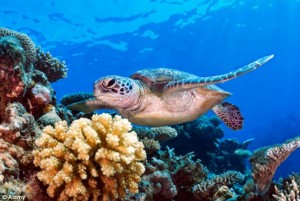Ahh, the power of the internet and open sources. For anyone studying ocean acidification, this is a nirvana of resources. DV
From: SeaWeb
Date: Wed, Jun 12, 2013 at 9:01 AM
June 11, 2013
OA indicates an open access article or journal.
– *Ocean acidification limits temperature-induced poleward expansion of coral habitats around Japan.
**Biogeosciences* 9(12): 4955-4968, 2012. *OA*
– *Observed acidification trends in North Atlantic water masses. **
Biogeosciences* 9(12): 5217-5230, 2012. *OA*
– *Spatiotemporal variability and long-term trends of ocean acidification in the California Current System.
**Biogeosciences*10(1): 193-216, 2013.*OA*
– *High tolerance of microzooplankton to ocean acidification in an Arctic coastal plankton community.
**Biogeosciences* 10(3): 1471-1481, 2013. *OA*
– *Short- and long-term consequences of larval stage exposure to constantly and ephemerally elevated carbon dioxide for
marine bivalve populations. **Biogeosciences* 10(4): 2241-2253, 2013. *OA*
– *Influence of ocean warming and acidification on trace metal biogeochemistry.
**Marine Ecology Progress Series* 470: 191-205, 2012. *OA*
– *Responses of marine primary producers to interactions between ocean acidification, solar radiation, and warming.
**Marine Ecology Progress Series* 470: 167-189, 2012. *OA*
– *Marine life on acid. **BioScience* 63(5): 322-328, 2013.
– *Red coral extinction risk enhanced by ocean acidification. **Scientific Reports* 3: art. 1457, 2013. *OA*
– *Dolomite-rich coralline algae in reefs resist dissolution in acidified conditions.
**Nature Climate Change* 3(3): 268-272, 2013.
– *Variation in plastic responses of a globally distributed picoplankton species to ocean acidification.
**Nature Climate Change* 3(3): 298-302, 2013.
– *Effects of ocean acidification on the embryos and larvae of red king crab, Paralithodes camtschaticus.
**Marine Pollution Bulletin* 69(1-2): 38-47, 2013.
– *Temperature and CO2 additively regulate physiology, morphology and genomic responses of larval sea urchins,
Strongylocentrotus purpuratus. **Proceedings of the Royal Society of London [B]* 280(1759): art. 20130155, 2013.
– *Addressing ocean acidification as part of sustainable ocean development. **Ocean Yearbook* 27: 29-46, 2013.
– *The marine inorganic carbon system along the Gulf of Mexico and Atlantic coasts of the United States: Insights from a
transregional coastal carbon study. **Limnology and Oceanography* 58(1): 325-342, 2013. *OA*
– *The responses of eight coral reef calcifiers to increasing partial pressure of CO2 do not exhibit a tipping point.
**Limnology and Oceanography* 58(1): 388-398, 2013. *OA*
– *Concentration boundary layers around complex assemblages of macroalgae: Implications for the effects of ocean
acidification on understory coralline algae. **Limnology and Oceanography* 58(1):121-130, 2013.
– *Interactive effects of elevated temperature and CO2 levels on metabolism and oxidative stress in two common marine
bivalves (Crassostrea virginica and Mercenaria mercenaria).
**Comparative Biochemistry and Physiology Part A: Molecular and Integrative Physiology* 164(4):545-553, 2013.
– *CO2-driven seawater acidification differentially affects development and molecular plasticity along life history of fish
(Oryzias latipes). *
*Comparative Biochemistry and Physiology Part A: Molecular and Integrative Physiology* 165(2): 119-130, 2013.
– *Preparing to manage coral reefs for ocean acidification: lessons from coral bleaching.
**Frontiers in Ecology and the Environment* 11(1): 20-27, 2013.
– *Marine fungi may benefit from ocean acidification. **Aquatic Microbial Ecology* 69(1): 59-67, 2013.
– *Effects of ocean acidification on early life-history stages of the intertidal porcelain crab Petrolisthes cinctipes.
**Journal of Experimental Biology* 216(8): 1405-1411, 2013.
– *Impact of ocean acidification on metabolism and energetics during early life stages of the intertidal porcelain crab
Petrolisthes cinctipes. **Journal of Experimental Biology* 216(8): 1412-1422, 2013.
– *Response to ocean acidification in larvae of a large tropical marine fish, Rachycentron canadum. **Global Change Biology*
19(4): 996-1006, 2013.
– *Interacting effects of ocean acidification and warming on growth and DMS-production in the haptophyte coccolithophore
Emiliania huxleyi.
**Global Change Biology* 19(4): 1007-1016, 2013.
– *Food availability outweighs ocean acidification effects in juvenile Mytilus edulis: laboratory and field experiments.
**Global Change Biology*19(4): 1017-1027, 2013.
– *Anthropogenic changes to seawater buffer capacity combined with natural reef metabolism induce extreme future coral reef
CO2 conditions. **Global Change Biology *19(5): 1632-1641, 2013.
– *Impacts of ocean acidification on marine organisms: quantifying sensitivities and interaction with warming.
**Global Change Biology*19(6): 1884-1896, 2013.*OA*
– *Detrimental effects of ocean acidification on the economically important Mediterranean red coral (Corallium rubrum).
**Global Change Biology* 19(6): 1897-1908, 2013.
– *Ocean acidification and warming scenarios increase micro-bioerosion of coral skeletons.
**Global Change Biology* 19(6):1919-1929, 2013.
– *Vulnerability of the calcifying larval stage of the Antarctic sea urchin Sterechinus neumayeri to near-future ocean
acidification and warming. **Global Change Biology *19(7): 2264-2275, 2013.
– *Does elevated pCO2 affect reef octocorals? **Ecology and Evolution*3(3): 465-473, 2013. *OA*
– *One-year experiment on the physiological response of the Mediterranean crustose coralline alga, Lithophyllum cabiochae, to
elevated pCO2 and temperature. **Ecology and Evolution* 3(3): 676-693, 2013. *OA*
– *Meta-analysis reveals complex marine biological responses to the interactive effects of ocean acidification and warming.
**Ecology and Evolution* 3(4): 1016-1030, 2013. *OA*
– *Near-future ocean acidification causes differences in microbial associations within diverse coral reef taxa.
**Environmental Microbiology Reports* 5(2): 243-251, 2013.
– *Consequences of increased temperature and acidification on bacterioplankton community composition during a mesocosm spring
bloom in the Baltic Sea. **Environmental Microbiology Reports* 5(2): 252-262, 2013.
– SeaWeb
– Marine Science Review
– Ocean Update
– Science Matters
– Marine Science Citations
– Contact Us
– Donate
SeaWeb and CFC
Support SeaWeb and Marine Science Review through the Combined Federal Campaign,code
No.*11796*.
SeaWeb in Action–Read about SeaWeb’s work
>>
Marine Photobank
Promoting Science and Conservation Through Imagery
Follow our Ocean in Focus photo essay series
>>
Ocean Voices
Read about scientists and others working for the ocean
>>
SeaWeb connects marine scientists to a global audience. Tell us about your
research at editor@seaweb.org so that we can highlight your work.
